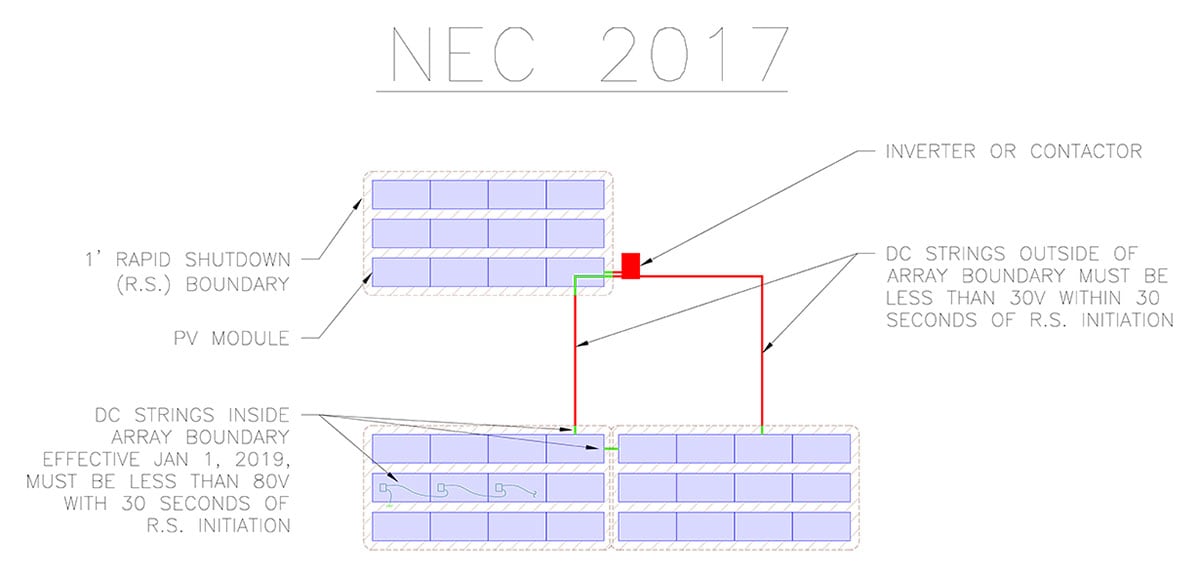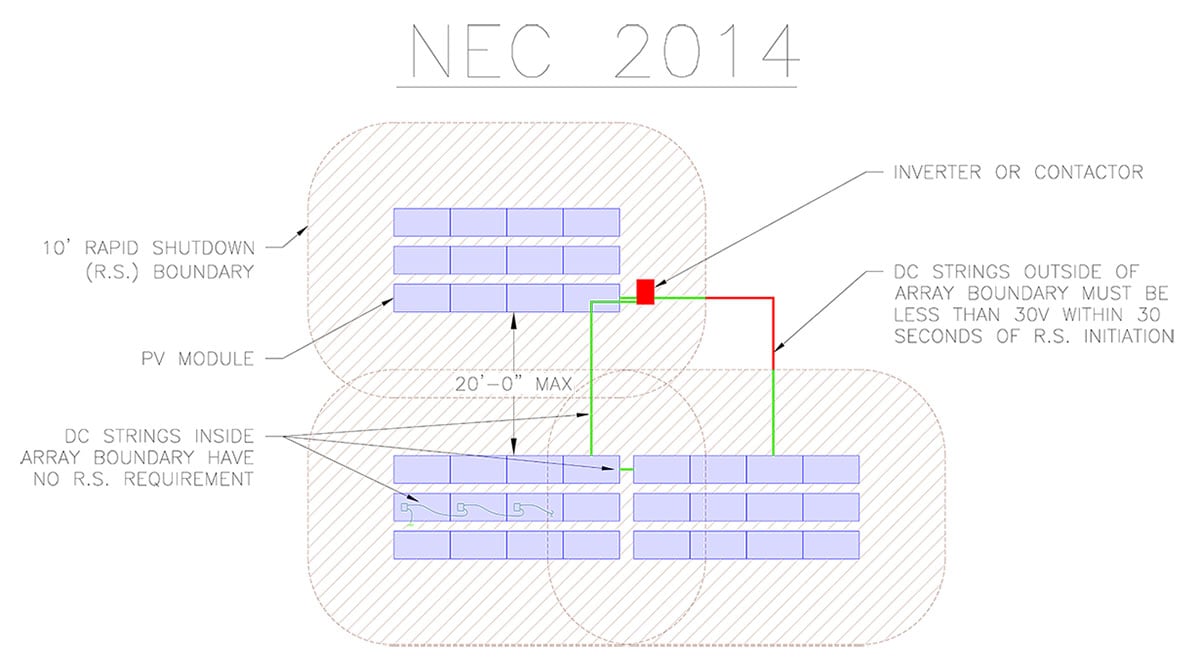The 2017 National Electric Code (NEC) dramatically changes the requirements for "Rapid Shutdown of PV Systems on Buildings." Half of the states already adopted NEC 2017 and several more will in the next few months (such as NJ and CT), so you can’t wait any longer to understand what these changes mean to your rooftop projects’ CapEx and OpEx (Pay close attention to Part 2 below). For a recap on the previous NEC 2014 requirements, see our article 2014 NEC 690.12 Rapid Shutdown For String Inverters On Flat Roofs.
The Goal of Rapid Shutdown:
PV system circuits installed on or in buildings shall include a rapid shutdown function to reduce shock hazard for emergency responders. In an emergency, the responders can initiate the rapid shutdown device, then safely move around the roof knowing any areas within 1' of an array may be energized. As long as they remain more than 1' from the array, any solar AC & DC conductors they encounter will be de-energized.
Rapid Shutdown Code – Part 1 (applies before and after January 1, 2019)
The Language of the Code 690.12(A) and (B)(1):
690.12 Rapid Shutdown of PV Systems on Buildings.
PV system circuits installed on or in buildings shall include a rapid shutdown function to reduce shock hazard for emergency responders in accordance with 690.12(A) through (D).
(A) Controlled Conductors. Requirements for controlled conductors shall apply to PV circuits supplied by the PV system.
(B) Controlled Limits. The use of the term, array boundary, in this section is defined as 305 mm (1 ft) from the array in all directions. Controlled conductors outside the array boundary shall comply with 690.12(B)(1) and inside the array boundary shall comply with 690.12(B)(2).
(1) Outside the Array Boundary. Controlled conductors located outside the boundary or more than 1 m (3 ft) from the point of entry inside a building shall be limited to not more than 30 volts within 30 seconds of rapid shutdown initiation. Voltage shall be measured between any two conductors and between any conductor and ground.
What this means to you:
So far, this is similar to the 2014 NEC code, except the distance from the array is now 1’ instead of 10’ with NEC 2014. Getting a string inverter within 1’ of the array can be tricky due to shading and working space concerns, but Pure Power has solutions that work on some projects. In some cases, contactor boxes or other equipment are needed with this 1’ requirement that weren’t needed in the NEC 2014 requirements.
The change from 10’ to 1’ greatly limits how we can jump between arrays. As shown in the images below, where you could once jump a gap between subarrays up to 20’ apart, you can now only jump a 2’ gap (which isn’t enough to cross the 8’ fire access paths required by NFPA1 or IFC).


Rapid Shutdown Code – Part 2 (Effective after January 1, 2019)
Language of the Code 690.12(B)(2):
(2) Inside the Array Boundary. The PV system shall comply with one of the following:
(1) The PV array shall be listed or field labeled as a rapid shutdown PV array. Such a PV array shall be installed and used in accordance with the instructions included with the rapid shutdown PV array listing and labeling or field labeling.
(2) Controlled conductors located inside the boundary or not more than 1 m (3 ft) from the point of penetration of the surface of the building shall be limited to not more than 80 volts within 30 seconds of rapid shutdown initiation. Voltage shall be measured between any two conductors and between any conductor and ground. This is the really important part!
(3) PV arrays with no exposed wiring methods, no exposed conductive parts, and installed more than 2.5 m (8 ft) from exposed grounded conductive parts or ground shall not be required to comply with 690.12(B)(2).
The requirement of 690.12(B)(2) shall become effective January 1, 2019.
What this means to you:
This “inside the array boundary” part is all new and doesn’t resemble the previous requirements. Sub-item 1 requires a UL standard that isn't out yet, and sub-item 3 is intended for BIPV, so we will skip both.
Sub-item 2 is the big one that changes the rooftop solar industry. Simply put, it's limiting the string voltage to 80Vdc. The days of 600V or 1000V strings are over… unless you use optimizers or MLPE that can throttle the voltage down to 80V when rapid shutdown is initiated. The 2 common & currently available ways to comply with this requirement will be:
1. String inverters with Module Level Power Electronics (MLPE) such as optimizers
2. Microinverters
For commercial scale projects microinverters don’t scale well, so using string inverters with MLPE or optimizers will be the most common solution. Yes this means you will need to start budgeting for higher Capital and Operating Expenses for projects in 2019 and beyond. As 2019 and 2020 progress, many innovative and cost-effective solutions will come to market, but there will be growing pains using the first products off the manufacturing line so be sure to increase your O&M budget! (We recommend PV Pros for third party O&M).
Rapid Shutdown Code – Part 3 (applies before and after January 1, 2019)
The remaining paragraphs of the code aren’t as shocking and apply both before and after January 1, 2019. Developers or EPC that use Pure Power for engineering won't need to worry about this section, as we will ensure you meet these new requirements without additional Capital or Operating expense.
The Language of the Code 690.12(B)(2):
(C) Initiation Device. The initiation device(s) shall initiate the rapid shutdown function of the PV system. The device “off” position shall indicate that the rapid shutdown function has been initiated for all PV systems connected to that device. For one-family and two-family dwellings, an initiation device(s) shall be located at a readily accessible location outside the building. The rapid shutdown initiation device(s) shall consist of at least one of the following:
(1) Service disconnecting means
(2) PV system disconnecting means
(3) Readily accessible switch that plainly indicates whether it is in the “off” or “on” position.
Where multiple PV systems are installed with rapid shutdown functions on a single service, the initiation device(s) shall consist of not more than six switches or six sets of circuit breakers, or a combination of not more than six switches and sets of circuit breakers, mounted in a single enclosure, or in a group of separate enclosures. These initiation device(s) shall initiate the rapid shutdown of all PV systems with rapid shutdown functions on that service. Where auxiliary initiation devices are installed, these auxiliary devices shall control all PV systems with rapid shutdown functions on that service.
(D) Equipment. Equipment that performs the rapid shutdown functions, other than initiation devices such as listed disconnect switches, circuit breakers, or control switches, shall be listed for providing rapid shutdown protection.
Explanation of the Code:
There are new requirements for the types of devices you use to initiate rapid shutdown. 99% of the time, Pure Power uses the PV system disconnecting means as the initiation device, which doesn’t require any additional listing. Occasionally we need to use a remote push-button device, which now needs to be listed for rapid shutdown. At the time of writing this article, the “listing” standards are still in development, meaning the listing requirement won’t apply until that is released and there are products on the market that have this listing.
.png)
